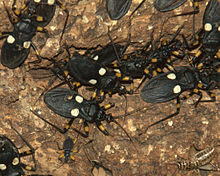 |
| P.biguttatus |
Friday 29 March 2013
Beetles and Bugs 6: Spot the difference
Saturday 23 March 2013
Beetles and Bugs 5: Lesser Goliath Beetle
 |
| M.polyphemus male |
One of the larger scarab beetles, males of this species can reach nearly 8 cm long, with females around 4cm maximum. Aside from size, the males can be distinguished by the ‘antlers’ on the head, which are not as well developed as those of the Rhinoceros beetle but are still useful in fighting with other males, for which reason males need to be kept separately in captivity.
 |
| M.polyphemus female |
Although brightly coloured, the metallic green of their wings is quite effective camouflage amongst rainforest foliage. They are not especially secretive, instead relying on their wings (they are good fliers) and well-armoured bodies to protect themselves. Large beetles like these do not have many predators as adults, although the larvae are favoured foods for many terrestrial mammals and reptiles, and their main threat is probably parasitic wasps, many of which are species-specific, although I have not been able to find much information on what parasitizes this particular species.
In captivity they are slightly harder to raise than the smaller species, but are well within the range of a home hobbyist. Basic rearing conditions are a suitably large container of rotting wood and dead leaves maintained at around 25 degrees for the larvae, supplemented with dry dog food to add nutrients. Adults feed on fruit such as banana, but need a covered container to prevent escape.
For more on raising these and other beetles, see here: http://www.bugnation.co.uk/viewforum.php?f=272
(images from wikipedia)
Monday 11 March 2013
Beetles and Bugs 4: Fregate Beetle
 |
| Fregate Beetle |
Tuesday 5 March 2013
Beetles and Bugs 3: Six-Spot Ground Beetle
Currently on show in Bug World is a large and spectacular ground beetle, the Six-Spotted ground Beetle Anthia sexguttata. Unlike the previous species in the series, they are most definitely carnivorous, and have impressive mandibles as armament.
Subscribe to:
Posts (Atom)
